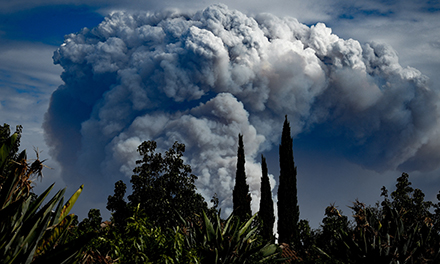
Smoke from the weekend’s fire in the Adelaide Hills could be seen from the suburbs. Picture: Bernard Humphreys
South Australia had the first real bushfire of the season at the weekend. Sadly, homes and buildings were lost. Trees were lost. But it was short, sharp and brought under effective control through the efforts of Forestry SA, the CFS, crews from the Department of Environment and Water, Metropolitan Fire Service and property owners with firefighting units. Source: Bruce Mitchell
A change in the weather and heavy rain also helped, but also hindered efforts.
Aerial firefighting units also played a big part both in the firefight and of course on the evening television news.
In fact, aerial firefighting units have become very much a “face” of firefighting in this country.
Aerial units have a value. They have their purpose.
But are the spectacular images of water bombers creating perhaps a false sense of security in the minds of those in suburban Australia?
The Institute of Foresters of Australia and Australian Forest Growers seem to think so and wants a greater focus on year-round bushfire prevention activities over the use of water bombing aircraft.
IFA/AFG president Bob Gordon sees a need to weigh-up the effectiveness and cost of relying on water-bombing aircraft as a reactive measure against the need for conventional wildfire responses and enhanced year-round prevention activities.
“We often see aircraft bombing established fires, and people think that they put the fires out. They don’t put forest fire out. It is ineffective to attempt to water bomb a large fire out,” Mr Gordon said.
He might be right. His opinion is based on information from people who know what they are talking about.
But unfortunately, it seems that the people making the decision on fire management may not be getting the same information.
Politicians know that the votes are in the city, and that seems to have been borne out by this week’s reshuffle of the Opposition’s shadow cabinet.
In all the activity of the bouncing of shadow ministers from one portfolio to another, one such move seems to have missed mainstream comment.
The Opposition quietly appointed its third Agriculture Minister in three months.
Tasmanian MP Julie Collins was taken from the aged services portfolio to agriculture which includes the forestry portfolio.
She replaces Ed Husic, appointed in November last year to replace Joel Fitzgibbon.
Some conflicting conclusions can be drawn from the move.
One is that the Labor Party can’t see past the climate change debate and believes that is where the votes are. And those votes generally aren’t in regional Australia, so agriculture and therefor the regions are perhaps dismissed as a lost cause and of no real interest to the ALP.
If the Opposition was really interested in regional Australia, surely the shadow agriculture minister would come from one of the eastern States, probably New South Wales.
That is not to say Ms Collins isn’t capable of doing the job. It has been suggested she is possibly only one of a handful of potential candidates for the job who know what is going on in regional Australia.
This line of thought is backed up by a suggestion that she has been selected to take on Tasmanian Liberal senator and Assistant Minister for Forestry and Fisheries Jonothan Duniam who has generally been seen to be doing a good job.
The Australian Forest Products Association says Ms Collins brings an understanding of the importance of the forestry sector to the national economy and to her home state of Tasmania.
The AFPA believes that as Tasmanian MP representing an electorate where forest-y is a major industry, she will have an understanding of its importance.
She may have the knowledge, she may have the understanding, but in an Opposition focussed fair and squarely on the climate change debate, will she have a voice that will be heard.
We can only hope so and wish her well in her new role.





